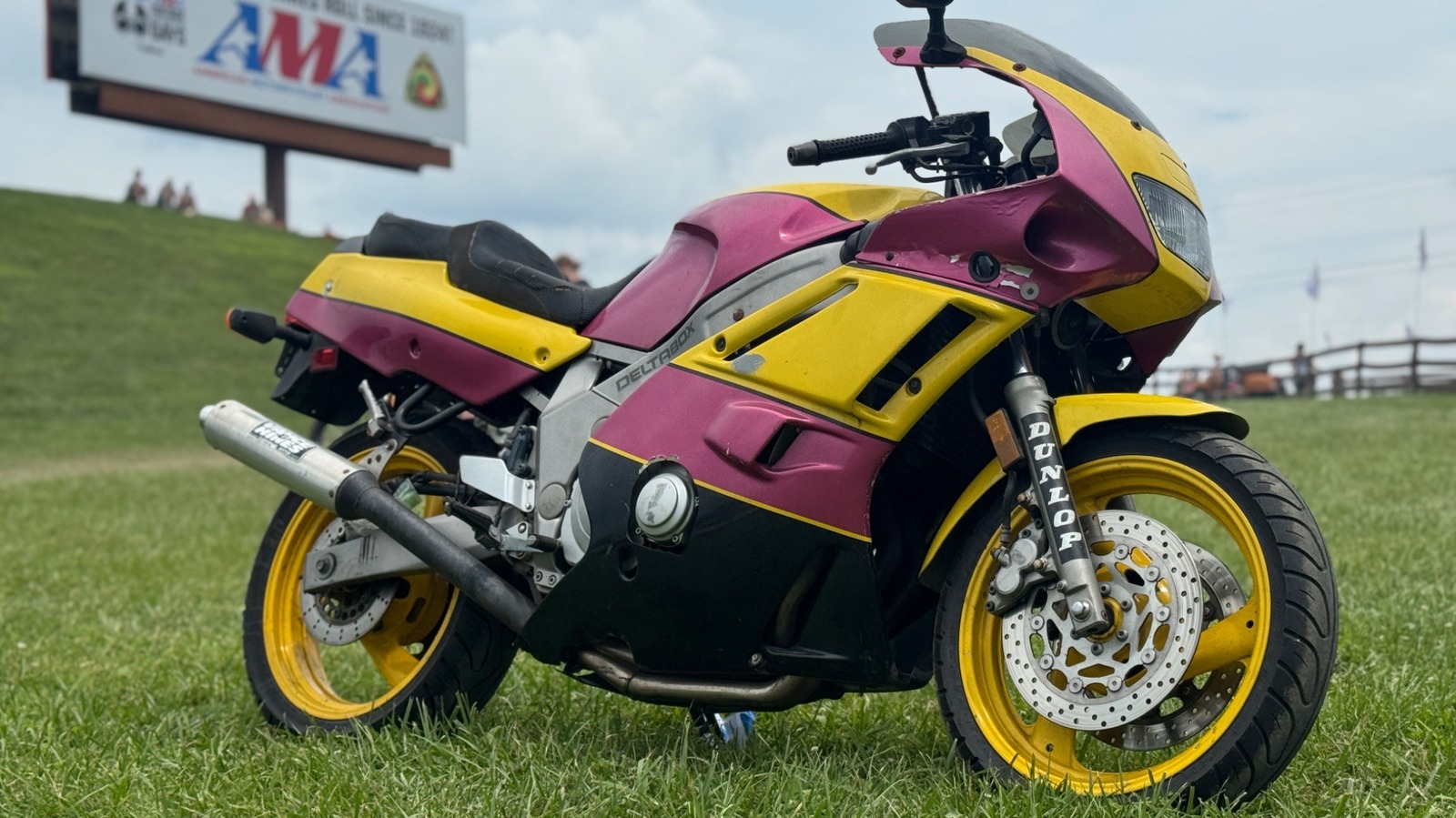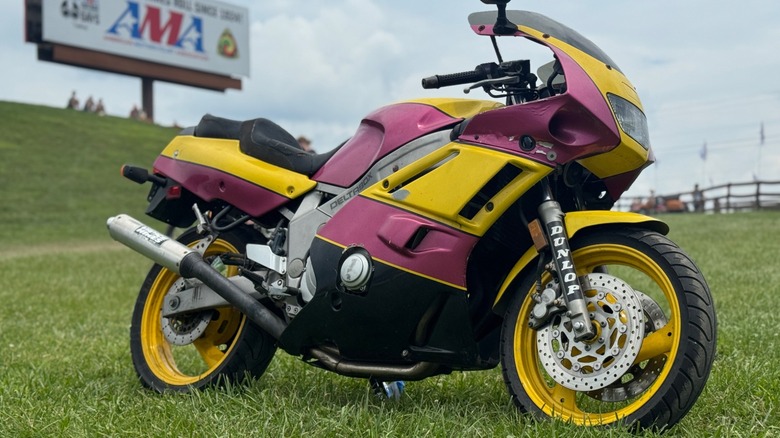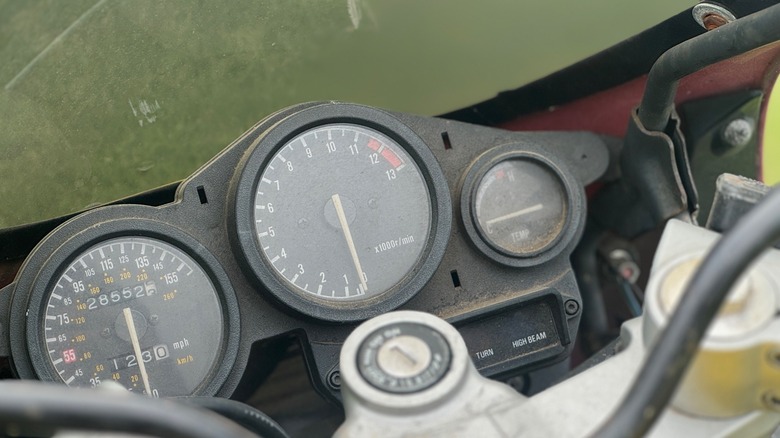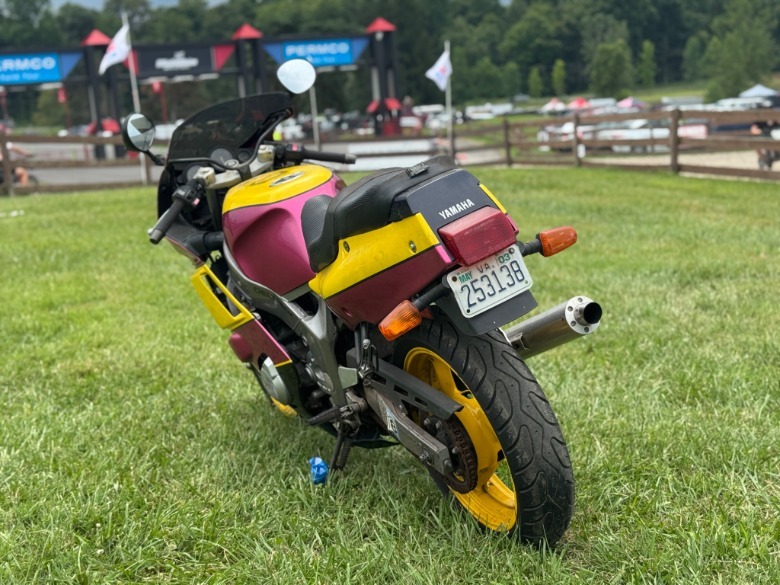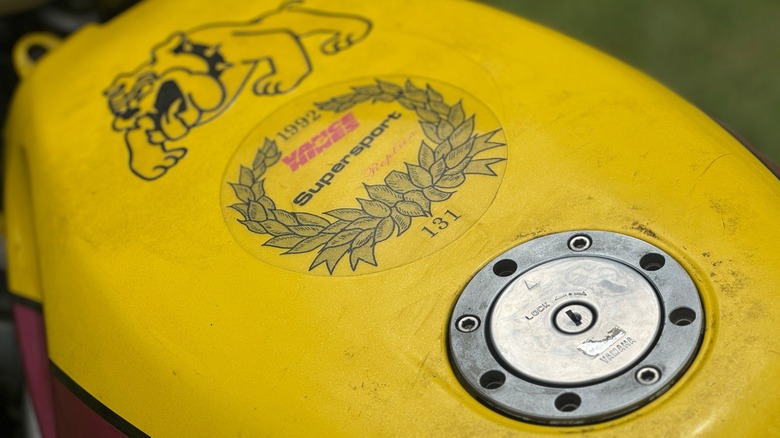During the AMA Vintage Days motorcycle event at Mid Ohio over the weekend, I—completely accidentally, mind you—added a sixth motorcycle to my stable. Amid all the two-wheeled shenanigans going on at the track, I stumbled across this 1992 Yamaha FZR 600 Vance & Hines Championship Edition motorcycle with a for sale sign taped to the front. On Friday the bike was listed, sans title, for just $1,000. I made a mental note of it and kept on trucking. Then, on Saturday, the price dropped to $700 and the seller added “all offers considered” and I became slightly more intrigued. A friend (and a handful of lunchtime beers) encouraged me to send a risky lowball offer.
“Saw your Yamaha for sale. If nobody else gets it by tomorrow, I have room in my van to haul it home and $500 in Venmo with your name on it,” was my offer. Just five minutes later, the seller texted back “If you give me the $500 now it’s yours.” I wasn’t looking forward to explaining to my wife why this stray was following me home, but a deal’s a deal and I’m a man of my word.
I couldn’t have scripted the exchange of money for keys better if I tried. The seller rolled up to meet me at the bike on a brutally hot Ohio day without a shirt. He told me some story about how the previous owner stopped riding the bike almost twenty years ago and it had been sitting in a garage until he died. That guy was the uncle of the seller’s friend and claim they’re still looking for the bike’s title, but it’s probably a lost cause. This magenta and yellow bike is hot, possibly in more ways than one.
So what is it?
So what’s so special about this brightly-colored 1990s monstrosity? Well, at its most basic, the FZR 600 was a pretty great 1990s sport bike. With an inline-four cylinder 599cc engine and a quartet of Mikuni carburetors, this bike pumped out a claimed 91 horses at 8,500 rpm (with an 11,500 rpm redline). At the time Yamaha was partnered with Vance & Hines Racing for its factory racing, winning its first Daytona 200 with David Sadowski in 199 and its first AMA Superbikes championship with Thomas Stevens in 1991. Both of those major milestones were completed with an FZR 600 wearing this ridiculously Rad-era magenta/yellow/black livery.
To celebrate the championship victory and Yamaha’s arrival in North American motorcycle racing, the company spun up a special limited edition bike with V&H. The bike was already pretty performance-packed from the word go, so they didn’t do a whole lot to set it apart. Each of the around 600 bikes built were painted in Vance & Hines livery and given an edition decal with a number (mine is #131), a Vance & Hines aftermarket exhaust system, and that’s pretty much it.
Yamaha said the FZR 600 weighed 458 pounds ready-to-ride, and when it was new the bike was capable of 150 miles per hour without issues. With a 41mm telescopic front fork and rising-rate rear monoshock, it was decently capable on track, and stopping power can whoa it down from those speeds thanks to a pair of 298mm discs up front and a 214mm disc at the back wheel. Unfortunately, those who run these on track say the rear shock and the front brakes are the first things to upgrade.
What’s bad about the bike?
If this thing is so great, why was it $500? A big reason is that missing title, of course. It also kind of runs like crap. I haven’t dug into the diagnosis yet, but it seems there’s something wrong in the fueling system that makes the bike shut down after a short time running. When the seller arrived to show me the bike, he stuck the key in and fired it right up with a quick stab of the starter button. While we were talking, perhaps one to two minutes later, the engine stumbled and shut off. Hmm, concerning, but not enough to deter me from striking the deal.
After I’d sent the seller some digital dead presidents trading cards in exchange for the keys to the motorcycle, he walked away and I got on the bike to ride it back to my campsite. As it had just a few minutes before, the Yamaha happily fired up and revved freely. Not only did the bike ride away under load, but I got it up to the top half of the rev range and shifted to second and then third. When I got slowed down for traffic, however, it once again stumbled and died. Only this time it wouldn’t re-start and I haven’t yet figured out why.
Is that it? In short, no. The tires are old, the bodywork is loose and many fasteners are missing, the windscreen is broken, the seat is falling apart, the chain could probably stand to be replaced, the rear brake caliper is in a dozen pieces in a Ziploc bag, and more. The paint, one of the bike’s big selling points, is ragged and in need of a few dozen touchups. Every part of this bike needs to be refurbished, repainted, replaced, or redone. It isn’t going to be the work of a moment to get this bike running well again, let alone track-ready.
It was last registered 22 years ago. A lot can happen to a bike in 22 years.
What’s good about the bike?
From the little riding that I got on this bike, it’s all reasonably functional. The seller handed me a cardboard box full of bits and spares, and a small handful of receipts. The bike has a fresh battery from just a couple of months ago, for which they paid around $120. The sale also included a Clymer and a Haynes manual, around $40 each. Throw in a few carburetor rebuild kits, a pack of carb jets, a fresh set of brake pads, and some other bits and bobs, and it looks like I bought a pile of parts and manuals and got the bike thrown in for free. The whole shooting match cost me less than 10% of the bike’s original $5199 pricepoint.
Despite the bike not wanting to start now, hearing it run was reassuring. There’s an engine there that wants to run, it just needs some help. I’ll get it running and dyno tuned before winter, and with any luck it’ll never be running this poorly again.
Goal number one is to get this machine back up on its feet, er back up on its tires, and running like a top again. Once that is sorted the rest will fall into place. My secondary goal is to get this bike below 400 pounds in ready-to-race shape. I’m going to do my best to get this done as cheaply and easily as possible, but not at the expense of safety. Yes, I’ll almost assuredly have to spend more on my leathers than on this bike, but I like my skin and would rather keep it.
So why the heck did I buy it?
I have no idea what kinds of lap times this thing will turn, or what it can do with modern rubber that it couldn’t manage in 1992, but I intend to find out. Maybe the bike will get faster than it ever has been, but I know for sure I need the on-track experience if I ever want to be a better rider. I had originally planned to track my Ducati Monster, but it’s just so nice that I’m not sure I can bring myself to do it until I’ve got more experience. I would still be sad if this Yamaha gets wadded up into a ball after high-siding me into oblivion, but I can afford to walk away from a $500 track rat. Balling up my Monster or my Livewire would make me sad in a very different way.
I have traditionally avoided sport bikes in my riding tenure, vastly preferring an upright riding style and no fairings. I’m not sure what it was about this bike, but it just drew me in, and begged me to take it home. From the second I got in the saddle, I knew it fit me like a glove and we would do great things together. With a handful of good bike tracks within two hours of my house, including Mid Ohio, Nelson Ledges, and Pitt Race, maybe this bike will be the one to fix me. Who knows, maybe I’ll enter it in AMA Vintage Days competition next summer.


